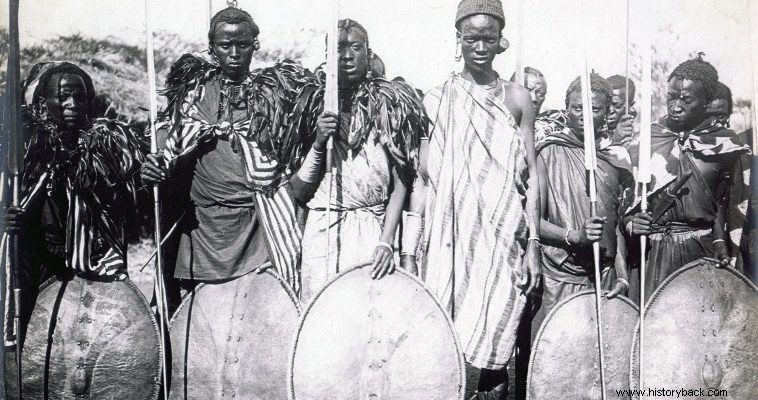
The Maasai are one of the African peoples who have written their own history in the Black Continent. For centuries they managed not only to survive, but also to impose their rule on the neighboring tribes, taking advantage of their brilliant martial culture.
The Maasai migrated to the area of present-day Kenya and Tanzania in the 18th century, descending from the North. They were probably racially related to the ancient inhabitants of the Upper Nile region, inhabitants of the famous kingdom of Meroe . The Maasai raised herds of cattle, which were the only important asset, both individually and tribally.
Until the appearance of Europeans equipped with repeating firearms, they were the undisputed masters of the African savannah, victoriously facing even the musket-equipped Arabs.
They were organized into 16 main tribal groups, which often fought each other as well, but mainly fought the neighboring African peoples and above all the Arab slave traders. A major cause of inter-tribal conflict was cattle-grabbing, while with the Arabs the reasons were even more obvious, as the latter raided Maasai villages in search of slaves to sell.
The Maasai military organization was purely tribal. Their army was organized into units, by age group – much like the Zulus. The young Maasai, before being called a warrior and receiving his weapons, had to go through a certain initiation ceremony.
After the ceremony he was called a warrior and could proudly carry his weapons, his large, wooden-framed, cowhide-covered shield, over two meters long, along with his wooden shaft, spear, with the deadly iron spike, which was almost 45cm long and 10cm wide.
The shield covered the warrior from the feet to the neck, while, according to testimonies, the multiple layers of hides he carried could stop even the momentum of a musket ball, from medium and long distance.
The Maasai maintained a standing army under arms, as, living from cattle breeding, they left the women, children and elders to take care of the animals. The only duty of men was war.
Concealed behind his large shield, the Maasai warrior could approach the opponent, literally pounce on him, like another ancient Greek warrior, shock him and spear him. Against opponents armed with firearms the warriors took advantage of any physical cover, approaching the opponent with leaps, before launching the final charge. If the ground offered no cover, the Maasai had learned to drop to the ground when the enemy charged and to move upon him when his gun was loaded.
Against opponents armed with muskets, these tactics worked satisfactorily. But against the Europeans armed with repeating firearms, with whom they came into conflict at the end of the 19th century, they did not work, firstly because repeating guns reloaded much faster than muskets and secondly because they had a terrible piercing capacity.
The Maasai lined up for battle in a formation of human wedges, which they called the "wing of the eagle." In this formation, the most capable warriors lined up in the center, in a wedge formation, facing the enemy, supported, on the sides and back, by similar formations of men.
They charged with great speed against the opponents and although on foot, cases have been recorded where they moved faster than Arabs on camels. Against their neighboring tribes their weaponry and tactics usually made them victorious.
They were only in trouble if the opponents were fortified. Against the Arabs they applied the tactics described above. In 1877 the Maasai attacked a caravan of 2,000 Arabs, killing them down to one. In 1887 the Maasai massacred another Arab caravan defended by 2,000 men armed with muskets. There was not a single survivor!
To the Europeans the Maasai showed no hostile disposition. This climate was changed by the Germans, when completely unnecessarily an exploratory party of 108 men entered the Maasai territory and refused to pay the toll tax that the Maasai always collected - in kind - from those who wanted to cross their lands. The Germans did not limit themselves to this but attacked a village, with the aim of grabbing food, even killing women and children.
The Maasai warriors pursued them, but for the first time their tactics failed against the repeating rifles of the opponents. Nevertheless, the Germans and their henchmen barely escaped with their lives, fleeing to an Arab, fortified camp.
The Maasai generally had good relations with the British and only in 1894 there was a small-scale conflict between them. In fact, in 1895 the British recruited Maasai units into their army that was fighting other tribes.
This climate did not change throughout the British colonial administration in East Africa.
Today the Maasai continue their traditional way of life, as much as possible, as Western civilization has invaded their areas as well. But they remain the same proud people, the only people of the savannah who did not submit to the "white man".
